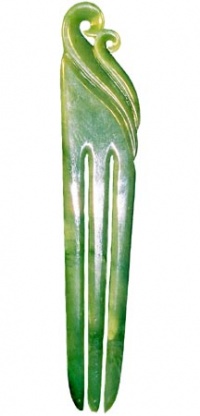Art Glossary of Terms
The Art History Archive
This Website is Best Viewed Using Firefox
INDEX -
A -
B -
C -
D -
E -
F -
G -
H -
I -
J -
K -
L -
M -
N -
O -
P -
Q -
R -
S -
T -
U -
V -
W - X - Y - Z

Art Glossary of Terms - Art Lexicon JA to JZ
jade - a green stone commonly found in China and Central America. Used to make jewelry, tools and weapons.
jaggies - In digital imaging, picture elements that are so large that the viewer becomes aware of them as small squares, with edges looking like zig-zags. Also see aliased and anti-aliased, definition, focus, pixels, image resolution, and vector graphic.
jalee work or jali - Urdu for a openwork stone screen usually carved of white marble or fine red sandstone. Jalee screens are most typically found in Mughal architecture, and simultaneously create a private space while producing patterns of light. They allow for cooling breezes to refresh on the hottest day, while their delicate tracery enhances the space and light in an interior environment.
jamb - The vertical sides of an opening. In Romanesque and Gothic churches, the jambs of windows and doors are often cut on a slant outward, or "splayed," thus providing a broader surface for sculptural decoration. Also see fenestration and splayed opening.
japan - A loose term for hard resinous varnishes that are either mixed with paints to achieve an opaque gloss, or they're cheap enamel paints, most often black and used to decorate articles made with sheet iron. Such decorations are said to have been jappaned. Also see chinoiserie.
Japanese mending tissue - A very thin, strong, transparent tissue paper, used by art conservators to strengthen old or worn paper or to repair tears in paper. Also see art conservation.
jataka - In Buddhism, tales of the lives the Buddha.
Java - This is a computer programming language with features especially well-suited to the network environment, with which programmers can create standalone programs and browser-based objects. In order to obtain everything you need to create Java programs, download a free copy of the Java Developer's Kit from Sun Microsystems, the company that developed Java. Also see World Wide Web (WWW).
JBIG - In digital imaging, an international compression standard designed for images with very little color or gray scale, such as images of document pages.
JFIF - JPEG File Format. File-storage format for images compressed with JPEG algorithm. Also see GraphicConverter.
Jin - A Chinese dynasty which lasted 1115 - 1234. (Not to be confused with the Western Jin Dynasty period which lasted 265 - 316.)
join - To connect, usually permanently. Means of joining include the use of adhesives, nails, nuts and bolts, mortice and tenon, pegs, rivets, screws, solder, staples, stitches, tapes, Velcro ®, weaving, mortar, welding, and wire. Also see artists' organizations, concatenation, fuse, joiner, ligature, and wood.
joiner - A carpenter, especially a cabinetmaker. A joiner's craft is called joinery. Also see join.
joint - A connection between two pieces of material.
Jomon - A pre-historic period in Japanese art history from about 4500 - 200 BCE. It was followed by the Yayoi period (c. 200 BCE - 200 CE).
JPEG - Joint Photographic Experts Group. Used to to refer to the standard they developed for still-image compression. Excellent file format for photographs used as Web graphics. Photoshop allows them to be saved at various quality settings — lower settings requiring less memory, permitting speedier downloading. Also see GIF, GraphicConverter, JFIF, PICT, TIFF, and World Wide Web (WWW).
jubé - In a Gothic cathedral, a choir screen (see screen). Also called a pulpitum.
Judaica - Jewish art, especially objects associated with religious ceremonies or practices.
judge and judgment - In art criticism, judgment is carefully thought out decision making in which one makes a personal decision about an artwork's success or lack of success (not like or dislike), preparing reasons to support this judgment. In art history, after describing, analyzing and interpreting a work, coming to thoughtful conclusions about the work's historical significance. Such conclusions might concern such things as a work's influence on other artists' works, or on the lives of its viewers. "Judgement" is an alternative spelling of "judgment", more commonly used in Britain than in the United States. Also see bias, brainstorming, interesting, and sentiment.
jukebox - In digital imaging, a stand-alone device that can hold several optical disks or magnetic tapes at a time, making it possible to switch among them at will.
jump cut - A cinematic technique used to disrupt narrative flow by arbitrarily omitting chunks from the middle of long continuous shots to dislocate any sense of progressive action. Also see time and tracking shot.
justified type - In typography, words spaced so that the lines align both on the left and on the right.
juvenilia - Works produced in an artist's youth.
juxtaposition, juxtapose - The state or position of being placed close together or side by side, so as to permit comparison or contrast.
|
|